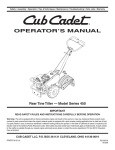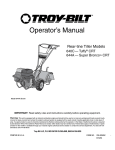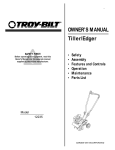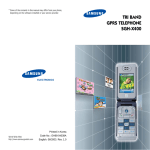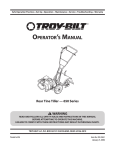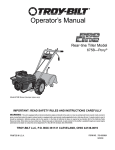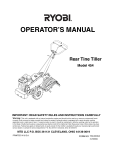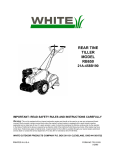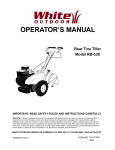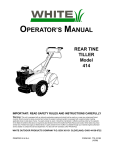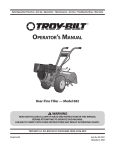Download Troy-Bilt 654J Tiller User Manual
Transcript
Operator’s Manual Rear-tine Tiller 654J—Thoroughbred™ D077 49 AC IMPORTANT: READ SAFETY RULES AND INSTRUCTIONS CAREFULLY WARNING: This unit is equipped with an internal combustion engine and should not be used on or near any unimproved forest-covered, brush-covered or grass-covered land unless the engine’s exhaust system is equipped with a spark arrester meeting applicable local or state laws (if any). If a spark arrester is used, it should be maintained in effective working order by the operator. In the State of California the above is required by law (Section 4442 of the California Public Resources Code). Other states may have similar laws. Federal laws apply on federal lands. A spark arrester for the muffler is available through your nearest engine authorized service dealer or contact the service department, P.O. Box 361131 Cleveland, Ohio 44136-0019. TROY-BILT LLC, P.O. BOX 361131 CLEVELAND, OHIO 44136-0019 PRINTED IN U.S.A. FORM NO. 769-01146.fm (3/17/2004) TABLE OF CONTENTS Content Customer Support Safety Assembly Features and Controls Operation Page 2 3 6 9 11 Content Maintenance and Adjustments Off-season Storage Troubleshooting Parts List Warranty Information Page 15 21 22 23 Back Cover FINDING MODEL NUMBER This Operator’s Manual is an important part of your new rear-tine tiller. It will help you assemble, prepare and maintain the unit for best performance. Please read and understand what it says. Before you start assembling your new equipment, please locate the model plate on the equipment and copy the information from it in the space provided below. A sample model plate is also given below. You can locate the model plate by standing behind the unit and looking down at rear surface of the tine shield. This information will be necessary to use the manufacturer’s web site and/or help from the Customer Support Department or an authorized service dealer. Copy the model number here: www.troybilt.com Copy the serial number here: TROY-BILT LLC P. O. BOX 3 6 1 1 3 1 CLEVELAND, OH 44136 330-558-7220 1-800-520-5520 CUSTOMER SUPPORT Please do NOT return the unit to the retailer from where it was purchased, without first contacting Customer Support. If you have difficulty assembling this product or have any questions regarding the controls, operation or maintenance of this unit, you can seek help from the experts. Choose from the options below: Visit troy-bilt.com for many useful suggestions. Click on Customer Support button and you will get the four options reproduced here. Click on the appropriate button and help is immediately available. The answer you are looking for could be just a mouse click away! The answer you are looking for could be just a mouse click away! If you prefer to reach a Customer Support Representative, please call 1(800) 520-5520. Engine Manual The engine manufacturer is responsible for all engine-related issues with regards to performance, power-rating, specifications, warranty and service. Please refer to the engine manufacturer’s Owner’s/Operator’s Manual, packed separately with your unit, for more information. 2 SECTION 1: IMPORTANT SAFE OPERATION PRACTICES WARNING: This symbol points out important safety instructions which, if not followed, could endanger the personal safety and/or property of yourself and others. Read and follow all instructions in this manual before attempting to operate this machine. Failure to comply with these instructions may result in personal injury. When you see this symbol—heed its warning. DANGER: This machine was built to be operated according to the rules for safe operation in this manual. As with any type of power equipment, carelessness or error on the part of the operator can result in serious injury. This machine is capable of amputating hands and feet and throwing objects. Failure to observe the following safety instructions could result in serious injury or death. California Proposition 65 Warning: WARNING: Engine exhaust, some of its constituents, and certain vehicle components contain or emit chemicals known to the State of California to cause cancer and birth defects or other reproductive harm. Training b. The gas cap shall never be removed or fuel added while the engine is running. Allow the engine to cool for several minutes before adding fuel. c. Keep matches, cigarettes, cigars, pipes, open flames, and sparks away from the fuel tank and fuel container. d. Fill fuel tank outdoors with extreme care. Never fill fuel tank indoors. Use a funnel or spout to prevent spillage. e. Replace all fuel tank and container caps securely. f. If fuel is spilled, do not attempt to start the engine, but move the machine away from the area of spillage and avoid creating any source of ignition until fuel vapors have dissipated. 1. Carefully read this Operator’s Manual, the separate Engine Owner/Operator’s Manual, and any other literature you may receive. Be thoroughly familiar with the controls and the proper use of the tiller and its engine. Know how to stop the unit and disengage the controls quickly. 2. Never allow children to operate the tiller. Never allow adults to operate the tiller without proper instruction. 3. Keep the area of operation clear of all persons, particularly children and pets. 4. Keep in mind that the operator or user is responsible for accidents or hazards occurring to other people, their property, and themselves. Preparation 1. Thoroughly inspect the area where the tiller is to be used and remove all foreign objects. 2. Be sure all control levers are released before starting the engine. 3. Do not operate the tiller without wearing adequate outer garments. Avoid loose garments or jewelry that could get caught in moving parts. 4. Do not operate the tiller when barefoot or wearing sandals, sneakers, or light footwear. Wear protective footwear that will improve footing on slippery surfaces. 5. Do not till near underground electric cables, telephone lines, pipes or hoses. If in doubt, contact your telephone or utility company. 6. Never make adjustments when engine is running (unless recommended by the Engine manufacturer). Operation 1. Do not put hands or feet near or under rotating parts. 2. Exercise extreme caution when on or crossing gravel drives, walks, or roads. Stay alert for hidden hazards or traffic. Do not carry passengers. 3. After striking a foreign object, stop the engine, thoroughly inspect the machine for any damage, and repair the damage before restarting and operating the machine. 4. Exercise caution to avoid slipping or falling. 5. If the unit should start to vibrate abnormally, stop the engine and check immediately for the cause. Vibration is generally a warning of trouble. 6. Stop the engine before unclogging the tines, or when making any repairs, adjustments or inspections. 7. Take all possible precautions when leaving the machine unattended. Stop the engine and move the Wheel Shift Lever to FORWARD. WARNING: Handle fuel with care; it is highly flammable and its vapors are explosive. Take the following precautions: a. Store fuel in containers specifically designed for this purpose. 3 20. Never operate the tiller without good visibility or light. 21. Never operate the tiller if you are tired, or under the influence of alcohol, drugs or medication. 22. Operators shall not tamper with the enginegovernor settings on the machine; the governor controls the maximum safe operating speed to protect the engine and all moving parts from damage caused by overspeed. Authorized service shall be sought if a problem exists. 23. Do not touch engine parts which may be hot from operation. Let parts cool down 24. Please remember: You can always stop the tines and wheels by releasing the Wheel Engagement Handle. 25. Use extreme caution when reversing or pulling the machine towards you. 26. Start the engine carefully according to instructions and with feet well away from the tines. 27. Never pick up or carry a machine while the engine is running. 8. Before cleaning, repairing, or inspecting, stop the engine and make certain all moving parts have stopped. 9. Always keep the tiller’s rear tine shield down. 10. Never use the tiller unless proper guards, plates, or other safety protective devices are in place. 11. Do not run engine in an enclosed area. Engine exhaust contains carbon monoxide gas, a deadly poison that is odorless, colorless, and tasteless. 12. Keep children and pets away. 13. Be aware that the tiller may unexpectedly bounce upward or jump backward if the tines should strike extremely hard packed soil, frozen ground, or buried obstacles like large stones, roots, or stumps. If in doubt about the tilling conditions, always use the following operating precautions to assist you in maintaining control of the tiller: a. Walk behind and to one side of the tiller, using one hand on the handlebars. Relax your arm, but use a secure hand grip. b. Use slower engine speeds. c. Clear the tilling area of all large stones, roots and other debris. d. Avoid using downward pressure on handlebars. If need be, use slight upward pressure to keep the tines from digging too deeply. e. Before contacting hard packed soil at the end of a row, reduce engine speed and lift handlebars to raise tines out of the soil. f. In an emergency, stop tines and wheels by releasing the Wheel Engagement Handle. Do not attempt to restrain the tiller. 15. Do not overload the tiller’s capacity by attempting to till too deeply at too fast a rate. 16. Never operate the tiller at high transport speeds on slippery surfaces. Look behind and use care when backing up. 17. Do not operate the tiller on a slope that is too steep for safety. When on slopes, slow down and make sure you have good footing. Never permit the tiller to freewheel down slopes. 18. Never allow bystanders near the unit. 19. Only use attachments and accessories that are approved by Troy-Bilt LLC. Maintenance and Storage 1. Keep the tiller, attachments and accessories in safe working condition. 2. Check all nuts, bolts, and screws at frequent intervals for proper tightness to be sure the equipment is in safe working condition. 3. Never store the tiller with fuel in the fuel tank inside a building where ignition sources are present such as hot water and space heaters, furnaces, clothes dryers, stoves, electric motors, etc.). Allow engine to cool before storing in any enclosure. 4. To reduce the chances of a fire hazard, keep the engine free of grass, leaves, or excessive grease. 5. Store gasoline in a cool, well-ventilated area, safely away from any spark- or flame-producing equipment. Store gasoline in an approved container, safely away from the reach of children. 6. Refer to the storage instructions in the Maintenance section of this Manual and the separate Engine Owner’s Manual for instructions if the tiller is to be stored for an extended period. 7. If the fuel tank has to be drained, do this outdoors. WARNING: YOUR RESPONSIBILITY Restrict the use of this power machine to persons who read, understand and follow the warnings and instructions in this manual and on the machine. 4 SAFETY LABELS FOUND ON YOUR TILLER WARNING CAUTION: WATCH OUT FOR HANDS. SLOWLY PULL STARTER ROPE BEYOND BUMPER BEFORE STARTING. Hot surfaces can cause severe burns. Do not touch muffler or adjacent areas. S30647 I20943 WARNING DEPTH STAKE WARNING TO AVOID SERIOUS INJURY 1. READ THE OPERATOR'S MANUAL. 2. KNOW LOCATION AND FUNCTIONS OF ALL CONTROLS. 3. KEEP ALL SAFETY DEVICES AND SHIELDS IN PLACE AND WORKING. 4. NEVER ALLOW CHILDREN OR UNINSTRUCTED ADULTS TO OPERATE TILLER. 5. SHUT OFF ENGINE BEFORE UNCLOGGING TINES OR MAKING REPAIRS. 6. KEEP BYSTANDERS AWAY FROM MACHINE. 7. KEEP AWAY FROM ROTATING PARTS. 8. USE EXTREME CAUTION WHEN REVERSING OR PULLING THE MACHINE TOWARDS YOU. SHALLOW / TRANSPORT POSITION KEEP AWAY FROM ROTATING TINES. ROTATING TINES WILL CAUSE INJURY. DEEP / FINAL TILLING POSITION 5 SECTION 2: ASSEMBLING THE TILLER 1 2 NOTE: All references to the RIGHT or LEFT side of the tiller are observed from operator’s position. Tools Needed for Assembly • • • • 9/16” Wrench 7/16” Wrench or Nutdriver Two 1/2” Wrenches Phillips Screwdriver (Handle Mount Bracket) (Control Box) (Threaded Cable Adjuster) (Control Box) 3 Attaching the Handle NOTE: Before beginning assembly, unfasten the cables and lay them across the back of the tiller. Having an assistant will ease completion of the following steps. 1. Remove the lower handle hardware (two hex screws, two lock washers, one carriage screw & one handle crank) from the tiller’s frame. 2. Position the handle mount bracket over the tiller frame. 3. Align the handle mount bracket’s rear holes (either upper or lower, depending on the operator’s height) with the holes in the tiller frame. Insert the carriage bolt through the holes from right to left and secure it with the handle crank. 4. Align the handle mount bracket’s front holes with the holes in the tiller frame. Using a 9/16” wrench, secure the handle mount bracket to the tiller frame with the hex screws and lock washers removed earlier. 4 6 5 6 Attaching the Control Box 5. Remove the four Phillips screws and lock nuts from the control box plate. 6. Insert the ends of the two springs into the holes found in the control levers located on the underside of the handle panel. 7. Using a Phillips screwdriver and a 7/16” wrench, secure the control box to the underside of the handle panel with the four screws and lock nuts removed earlier. 7 7 8 9 Attaching the Shift Cable 8. Place the shift lever in the forward position. Insert the end of the shift cable into the hole in shift lever located on the underside the handle panel. 9. Position the shift cable’s threaded adjuster in the slot found on the shift lever mount bracket. (one nut below the mount bracket and the flat washer, lock washer and second nut above the mount bracket. See Inset). 10. Adjust the shift cable as follows: a. Using a ½” wrench, thread the bottom nut upward until the cable is taut. b. Using a ½” wrench, thread the top nut downward to secure the adjuster to the mount bracket. Position the shift cable (and three other cables) against the left handle tube. Secure them to the handle with the cable tie provided as shown in the illustration at the top of the page. 10 B A Gas and Oil Fill-up Gasoline Service the engine with gasoline as instructed in the separate Briggs & Stratton Operator/Owner Manual packed with your tiller. Read instructions carefully. Oil IMPORTANT: Pour the entire contents of the provided oil bottle into the engine’s oil fill. 8 SECTION 3: KNOW YOUR TILLER Wheel Engagement Handle Wheel Shift Lever Tine Engagement Lever Tine Direction Selector Depth Regulator Lever (Depth Stake) Engine Starter Handle Handle Height Adjuster Wheel Engagement Handle Read this operator’s manual and safety rules before operating your tiller. Compare the illustrations above with your unit to familiarize yourself with the location of various controls. Save this manual for future reference. The wheel engagement handle is located below the tiller’s upper handle. Engine Closing the wheel engagement handle with the wheel shift lever in either FORWARD or REVERSE will cause the tiller’s wheels to drive. See the Briggs & Stratton Owner/Operator manual packed with your unit for the location and function of the controls on the engine. Starter Handle The starter handle is located on the engine. Pull the starter handle to start engine. Releasing/Opening the wheel engagement handle automatically stops the tiller’s wheels from driving Wheel Shift Lever The shift lever is located on the right side of the handle panel and has three positions, FORWARD, NEUTRAL and REVERSE. Place the wheel shift lever in either FORWARD or REVERSE before engaging the drive handle. Always bring the tiller to a complete stop prior to moving the shift lever from FORWARD to REVERSE or vice-versa. IMPORTANT: Never force the shift lever. Doing so may result in serious damage to the tiller’s transmission. NOTE: If the tiller’s tines and wheels are engaged, releasing/ opening the wheel engagement handle automatically stops BOTH the tiller’s tines and the tiller’s wheels from driving. WHEEL DRIVE F N R I22311 AC 9 Tine Direction Selector Tine Engagement Lever The tine engagement lever is located on the left side of the handle panel and has two positions, ON and OFF. To engage the tines and begin tilling, place the lever in the ON position. To disengage the tines, move the lever into the OFF position. The tine direction selector (found in the lower left area the handle panel) is used to alternate tine rotation between FRT mode (Forward Rotating Tines) to CRT mode (Counter Rotating Tines). • Operate the tiller in CRT mode when tilling virgin ground, sod or hard soil. • Operate the tiller in FRT mode when cultivating or tilling soft ground or previously tilled soil. NOTE: The tIne engagement lever cannot be placed in the ON position without first closing the wheel engagement handle. Also, the tIne engagement lever cannot be placed in the ON position unless the wheel shift lever is in the FORWARD position. Refer to Safety Interlock System on Page 11. IMPORTANT: When operating the tiller in FRT mode, always lower the depth regulator lever (for a shallower tilling depth). ON TINES Depth Regulator Lever The highest notch (lever all the way down) raises the tines approximately 1/2-inch off the ground. This “travel” position allows the tiller to be moved without the tines digging into the ground. OFF SHALLOW / Handle Height Adjuster TRANSPORT The handle mount bracket can be adjusted downward (for shorter operators) or upward (for taller operators) using the handle height adjuster. Align the handle mount bracket’s rear holes with the holes in the tiller frame. Insert the carriage bolt through the holes from right to left and secure it with the handle crank. POSITION Moving the lever up increases the tilling depth. The lowest notch allows a tilling depth of approximately six to eight inches, depending on soil conditions. DEEP / FINAL TILLING POSITION 10 SECTION 4: OPERATING YOUR TILLER WARNING: Read, understand, and follow all 7. Set the tilling depth by moving the depth regulator lever rearward, then either up or down into the desired depth setting. Refer to Depth Regulator Lever on Page 10. instructions and warnings on the machine, in this manual and the Briggs & Stratton Owner/ Operator manual packed with your unit before operating the tiler. NOTE: Move the Depth Regulator Lever into the “travel” position (lever all the way down) so that the tines clear the ground. Use this position when practicing with or transporting the tiller. When you are ready to begin tilling, move the Depth Regulator Lever into the desired depth setting. Refer to Depth Regulator Lever on Page 10. Safety Interlock System IMPORTANT:Your tiller is equipped with an interlock system for the protection of the operator. If the interlock system should ever malfunction, do not operate the tiller. Contact an authorized service dealer. • • • • • Starting Engine The Wheel Engagement Handle must be in the closed position in order to engage the tines The Wheel Shift Lever must be in the FORWARD position in order to engage the tines. The Wheel Shift Lever cannot be moved out of the FORWARD position unless the Tine Engagement Lever is in the OFF position. The tines will automatically stop if the operator releases the Wheel Engagement Handle. The wheels will automatically stop if the operator releases the Wheel Engagement Handle. • Move choke control lever to CHOKE position. WARNING: Do not operate the tiller if the NOTE: A warm engine may not require choking. interlock system is malfunctioning. This system was designed for your safety and protection. • Move throttle control lever to FAST (rabbit) position. • Grasp the starter handle and pull the rope out slowly until resistance is felt. When it becomes slightly harder to pull the rope, slowly allow the rope to recoil. Then pull rope with a rapid, continuous, full arm stroke. Keep a firm grip on starter handle. Maintain a grip on the starter handle and allow the rope to recoil slowly. Repeat the previous steps until engine starts. When engine starts, move choke control gradually toward the RUN position until the engine is running smoothly. Pre-Start Checklist Do the following before starting the engine. 1. Check unit for loose or missing hardware. Service as required. 2. Check motor oil level. Refer to separate Briggs & Stratton Operator/Owner Manual. 3. Check that all safety guards and covers are in place. 4. Check air cleaner and engine cooling system. Refer to separate Briggs & Stratton Operator/Owner Manual. 5. Select a tine direction (Refer to Tine Direction Selector on page 10). 6. Fill the fuel tank with gasoline as instructed in the separate Briggs & Stratton Operator/Owner Manual packed with your tiller. Read instructions carefully. • • WARNING: Gasoline is highly flammable and its vapors are explosive. Follow gasoline safety rules found on Page 3 in this manual, and in the separate Briggs & Stratton Operator/Owner Manual. Failure to follow gasoline safety instructions can result in serious personal injury and property damage. WARNING: Never run the engine indoors or in a poorly ventilated area. Engine exhaust contains carbon monoxide, an odorless and deadly gas. 11 Stopping Engine • 4. For forward motion of the wheels and power to the tines: a. Place the tine direction selector in either the CRT position or FRT position. Move throttle control lever to STOP position. See Figure 1. NOTE: Operate the tiller in CRT mode when tilling virgin ground, sod or hard soil. Operate the tiller in FRT mode when cultivating or tilling soft ground or previously tilled soil. b. Place the wheel shift lever in the FORWARD position. c. Close the wheel engagement handle against the handlebar to cause the wheels to drive. d. Place the tine engagement lever in the ON position to begin tilling. Figure 1 CAUTION: Never stop the engine by moving the choke lever into the CHOKE position. Backfire, fire or engine damage could result. IMPORTANT: To stop the wheels and tines, release the wheel engagement handle. WARNING: Do not push down on the handlebar to try to make the tiller till more deeply. Doing so prevents the wheels from holding the tiller back and can allow the tines (in CRT mode) to rapidly propel the tiller backward toward the operator, which could result in loss of control, property damage, or personal injury. Operating the Tiller WARNING: Before tilling new ground, contact your telephone and utilities company to inquire if underground lines are on the property. The following pages provide guidelines to using your tiller effectively and safely in various gardening applications. Be sure to read Tilling Tips & Techniques in this Section before you actually put the tines into the soil. • 1. Follow the Pre-Start Checklist on page 11. Be sure that the wheel shift lever is in the NEUTRAL position. 2. Start the engine and allow it to warm up for a few minutes. Move the throttle control into the FAST speed setting. • • • IMPORTANT: Always operate the tiller with the throttle in the FAST (rabbit) position. 3. For forward or reverse motion of the wheels and no power to the tines: a. Place the tine engagement lever in the OFF position. b. Place the wheel shift lever in either the FORWARD position or REVERSE position. As the tiller moves forward, relax and let the wheels pull the unit along while the tines dig. Walk behind, and a little to one side of the tiller. Use a light but secure grip with one hand on the handlebars, but keep your arm loose. Let the tiller move ahead at its own pace. Do not push down on the handlebar in an attempt to force the tiller to dig deeper. If necessary, stop the tiller, turn off the engine and reposition the depth regulator lever to adjust tilling depth before restarting and operating the tiller. 5. To turn the tiller around: a. Practice turning in a level, open area with the tines not engaged. b. To start a turn, carefully raise the handlebar until the engine and tines are balanced over the wheels. c. With the tiller balanced, push sideways on the handlebar to move the tiller in the direction of the turn. After completing the turn, slowly lower the tines into the soil. NOTE: If you encounter difficulty repositioning the wheel shift lever from FORWARD or REVERSE into NEUTRAL or vice-versa, gently rock the tiller (slightly push-and-pull the handlebar forward and backward) prior to moving the wheel shift lever. Doing so will help fully disengage the transmission’s internal drive clutch. Stopping the Tiller and Engine 1. To stop the wheels and tines, release /open the wheel engagement handle. 2. To stop the engine, move the engine throttle lever to STOP. Refer to Figure 1. c. Close the wheel engagement handle against the handlebar to cause the wheels to drive. To stop the wheels, release the wheel engagement handle. 12 TILLING TIPS & TECHNIQUES Tilling Depths • This tiller can be operated in CRT (counter-rotating tine) mode. As the wheels pull forward, the tines rotate backward. This creates an “uppercut” tine action which digs deeply, uprooting soil and weeds. Don’t overload the engine when operating in CRT mode, but dig as deeply as possible on each pass. On later passes, the wheels may tend to spin in the soft dirt. Help them along by lifting up slightly on the handlebar (or simply switch to operating in FRT mode). WARNING: Before tilling, contact your telephone or utilities company and inquire if • Avoid the temptation to push down on the handlebar in an attempt to force the tiller to dig underground equipment or deeper. Doing so takes the weight off the powered wheels, causing them to lose traction. lines are used on your Without the wheels to hold the tiller back, the tines will attempt to propel the tiller backward, property. Do not till near towards the operator. (Sometimes, slight downward pressure on the handlebar will help get buried electric cables, through a particularly tough section of sod or unbroken ground, but in most cases this won’t telephone lines, pipes or be necessary.) hoses. • When cultivating (breaking up surface soil around plants to destroy weeds), adjust the tines to dig only 1" to 2" deep. Using shallow tilling depths helps prevent injury to plants whose roots often grow close to the surface. If needed, lift up on the handlebar slightly to prevent the tines from digging too deeply. (Cultivating on a regular basis not only eliminates weeds, it also loosens and aerates the soil for better moisture absorption and faster plant growth.) Watering the garden area a few days prior to tilling will make tilling easier, as will letting the newly worked soil set for a day or two before making a final, deep tilling pass. Choosing Correct Tine Depth & Rotation With experience, you will find the “just right” tilling depth and tine rotation combination that is best for your garden under specific conditions. • Operate the tiller in CRT mode when tilling virgin ground, sod or hard soil. • Operate the tiller in FRT mode when cultivating or tilling soft ground or previously tilled soil. IMPORTANT: When operating the tiller in FRT mode, always lower the depth regulator lever (for a shallower tilling depth). Let the Tiller Do the Work Avoid Making Footprints While tilling, relax and let the wheels pull the tiller along while the tines do the digging. Walk on the side that is not yet finished (to avoid making footprints in the freshly tilled soil) and lightly, but securely grip the handlebar with just one hand. Always operate the tiller with the throttle in the FAST (rabbit) position. Avoid Tilling Soggy, Wet Soil Whenever possible, walk on the untilled side of the unit to avoid making footprints in your freshly tilled or cultivated soil. Footprints cause soil compaction that can hamper root penetration and contribute to soil erosion. They can also “plant” unwanted weed seeds back into the freshly tilled ground. Tilling wet soil often results in large, hard clumps of soil that can interfere with planting. If time permits, wait a day or two after heavy rains to allow the soil to dry before tilling. Test soil by squeezing it into a ball. If it compresses too easily, it is too wet to till. Preparing Seedbeds • When preparing a seedbed, go over the same path twice in the first row, then overlap one-half the tiller width on the rest of the passes (see Seedbed 1). When finished in one direction, make a second pass at a right angle (Seedbed 2). Overlap each pass for best results (in very hard ground, it may take three or four passes to thoroughly pulverize the soil.) Seedbed 1 Cultivating • If the garden size will not permit lengthwise and then crosswise tilling, then overlap the first passes by one-half a tiller width, followed by successive passes 1 at one-quarter width (see Seedbed 2 3). 3 Seedbed 3 13 With planning, you can allow enough room between rows to cultivate. Leave room for the hood width, plus enough extra room for future plant growth. Seedbed 2 TILLING TIPS & TECHNIQUES (CON’T) Tilling On Slopes Read the following recommendations before tilling on slopes: If you must garden on a moderate slope, please follow two very important guidelines: 1. Till only on moderate slopes, never on steep ground where footing is difficult (review safety rules in Section 1: Safety of this manual). 2. We recommend tilling up and down slopes rather than terracing. Tilling vertically on a slope allows maximum planting area and also leaves room for cultivating. IMPORTANT: When tilling on slopes, be sure the correct oil level is maintained in the engine (check every one-half hour of operation). The incline of the slope will cause the oil to gravitate away from its normal level and this can starve engine parts of required lubrication. Keep the motor oil level at the full point at all times! WARNING: Do not operate tiller on a slope too steep for safe operation. Till slowly and be sure you have good footing. Never permit tiller to freewheel down slopes. Failure to follow this warning could result in personal injury. Tilling Up and Down Slopes (Vertical Tilling) • To keep soil erosion to a minimum, be sure to add enough organic matter to the soil so that it has good moisture-holding texture and try to avoid leaving footprints or wheel marks. • When tilling vertically, try to make the first pass uphill as the tiller digs more deeply going uphill than it does downhill. In soft soil or weeds, you may have to lift the handlebars slightly while going uphill. When going downhill, overlap the first pass by about one-half the width of the tiller. Clearing the Tines The tines have a self-clearing action which eliminates most tangling of debris in the tines. However, occasionally dry grass, stringy stalks or tough vines may become tangled. Follow these procedures to help avoid tangling and to clean the tines, if necessary. • To reduce tangling, set the depth regulator deep enough to get maximum “chopping” action as the tines chop the material against the ground. Also, try to till under crop residues or cover crops while they are green, moist and tender. • While tilling, try swaying the handlebars from side to side (about 6" to 12"). This “fishtailing” action often clears the tines of debris. • If tangling occurs, lift the tines out of the soil and run the tiller in reverse for a few feet. This reversing action should unwind a good deal of debris. Loading and Unloading the Tiller WARNING: Loading and unloading the tiller into a vehicle is potentially hazardous. Doing so is NOT recommend unless absolutely necessary, as this could result in personal injury or property damage. However, if you must load or unload the tiller, follow the guidelines given next. • Before loading or unloading, stop the engine, wait for all parts to stop moving and allow the engine and muffler cool. • The tiller is too heavy and bulky to lift safely by one person. Two or more people should share the load. • It may be necessary to remove the debris by hand (a pocket knife will help you to cut away the material). • Use sturdy ramps and manually (engine shut off) roll the tiller into and out of the vehicle. Two or more people are needed to do this. • The ramps must be strong enough to support the combined weight of the tiller and any handlers. The ramps should provide good traction to prevent slipping; they should have side rails to guide the tiller along the ramps; and they should have a locking device to secure them to the vehicle. • The handlers should wear sturdy footwear that will help to prevent slipping. • Position the loading vehicle so that the ramp angle is as flat as possible (the less incline to the ramp, the better). Turn the vehicle’s engine off and apply its parking brake. • When going up ramps, stand in the normal operating position and push the tiller ahead of you. Have a person at each side to turn the wheels. 14 WARNING: Before clearing the tines by hand, stop the engine, allow all moving parts to stop. Failure to follow this warning could result in personal injury. • When going down ramps, walk backward with the tiller following you. Keep alert for any obstacles behind you. Position a person at each wheel to control the speed of the tiller. Never go down ramps tiller-first, as the tiller could tip forward. • Place wooden blocks on the downhill side of the wheels if you need to stop the tiller from rolling down the ramp. Also, use the blocks to temporarily keep the tiller in place on the ramps (if necessary), and to chock the wheels in place after the tiller is in the vehicle. • After loading the tiller, prevent it from rolling by placing the wheel shift lever in the FORWARD position. Chock the wheels with blocks and securely tie the tiller down. SECTION 5: MAINTENANCE AND ADJUSTMENTS Cleaning the Tiller WARNING: Before performing any maintenance, or repairs, turn the engine off and allow it to cool, move the tiller to a level surface, place the wheel shift lever in the FORWARD position and chock the tiller’s wheels. Any fuel or oil spilled on the machine should be wiped off promptly. Do NOT allow mud and debris to accumulate around the cooling fins of the engine or on any other part of the machine, especially around the bottom frame cover, under the belt cover, around the belts, pulleys, shifter linkage and other moving parts. MAINTENANCE SCHEDULE PROCEDURE Check motor oil level Clean engine Check drive belt tension Check nuts and bolts Change motor oil Lubricate tiller Service foam pre-cleaner air filter Service paper air filter Check gear oil level in transmission Check tines for wear Check air pressure in tires Service spark plug Clean tiller NOTES 2, 3 2, 7 1, 4 1, 4 1, 4, 6 4, 8 7 7 1, 5 5 5 7 8 • • Remove the belt cover at least once a season and clean any debris away from belts and pulleys Clean around the bottom frame cover and the underside of the tine shield and with a garden hose after each use. IMPORTANT:Thoroughly dry the tine shield and entire machine after each cleaning. Lubricate any pivot points and all axles to inhibit rust from forming and metal parts from corroding and seizing over time. Lubrication WARNING: Before performing any maintenance or repairs, turn the engine off and allow it to cool, move the tiller to a level surface, place the wheel shift lever in the FORWARD position and chock the tiller’s wheels. NOTES 1. 2. 3. 4. 5. 6. 7. After first 2 hours of break-in operation. Before each use. Every 5 operating hours. Every 10 operating hours. Every 30 operating hours. Change more frequently in dusty or dirty conditions. See Engine Owner’s Manual for service recommendations. 8. After each use. Engine Lubricate the engine with motor oil as instructed in the Briggs & Stratton Operator/Owner Manual packed with your unit. Pivot Points & Linkage Lubricate all the pivot points on the depth regulator lever, handle height adjuster and levers (found on underside of the handle panel) at least once a season with light oil. Remove the belt cover at least once a season and clean any debris away from belts and pulleys before lubricating pivot points on pulley brackets with a light oil. Engine Check engine oil level before each use as instructed in the Briggs & Stratton Operator/Owner Manual packed with your unit. Follow the instructions carefully. Engine Oil Axles (Wheel & Tine) Refer to the Briggs & Stratton Operator/Owner Manual packed with your unit for instruction on changing the engine oil and for information regarding the quantity and proper weight of motor oil. Remove each wheel and tine holder from its axle at least once a season and before extended storage. Clean each axle and lubricate with an all-purpose grease before reinstalling each wheel and tine holder. Air Cleaner Service the pre-cleaner, if so equipped, and cartridge/air cleaner element as instructed in the Briggs & Stratton Operator/Owner Manual packed with your unit. Transmission Spark Plugs Before each use, check your tiller for signs of an oil leak— usually a dirty, oily accumulation either on the unit or on the floor where it has been parked. Checking for Oil Leaks The spark plug should be cleaned and the gap reset once a season. Refer to the Briggs & Stratton Operator/Owner Manual for correct plug type and gap specifications. A little seepage around a cover or oil seal is usually not a cause for alarm. If a small puddle forms below the tiller within hours, however, then service is required. 15 Ignoring a leak can result in severe transmission damage. If a cover leaks, try tightening any loose screws or bolts. If the fasteners are tight, a new gasket or oil seal may be required. If the leak is from around a shaft and oil seal, the oil seal probably needs to be replaced. See an authorized service dealer. Changing Oil Oil level should be visually checked if evidence of a leak is present. Oil should be added in such cases, but changing the transmission oil as part of general maintenance is unnecessary Checking Oil Level Check the oil level after every 30 hours of operation and whenever there is any oil leakage. IMPORTANT:Never operate the tiller if the transmission is Figure 3 low on oil. IMPORTANT: If loosened or removed, a sealant (Loctite 1. Position the tiller on a level surface. 2. Remove the fill plug found on the front of the transmission. See Figure 2. Ultra Black™ Silicone 5900) must be applied to these screws before they can be reused without risking the loss of transmission oil. Adjustments WARNING: Before performing any maintenance or repairs, turn the engine off and allow it to cool, move the tiller to a level surface, place the wheel shift lever in the FORWARD position and chock the tiller’s wheels. Handle Height The handle mount bracket can be adjusted downward (for shorter operators) or upward (for taller operators) using the handle height adjuster. • Figure 2 • 3. The drive shaft (visible through the transmission plug opening) should be half-submerged. If necessary, slowly add SAE 85W140 oil until the drive shaft is approximately half-submerged. • IMPORTANT: Do NOT add oil to the top of the Unthread the handle crank and remove the carriage bolt which secures handle mount bracket to the tiller frame. See Figure 4. Pivot the handlebar upward or downward to align the handle mount bracket’s rear holes (either upper or lower) with the holes in the tiller frame. Re-insert the carriage bolt through the holes from right to left and secure it with the handle crank. transmission housing. Do NOT fully submerge the drive shaft with oil. Doing so will not allow for oil expansion and may result in serious damage to the transmission . Checking Hardware Check the unit for loose or missing hardware after every 10 operating hours. Loose or missing hardware can lead to equipment failure, poor performance, or oil leaks. Be sure to check the three mounting screws located on each of two end caps found at the rear of the transmission (See Figure 3). Lift the tine flap to service those screws. Figure 4 16 Shift Cable If the tiller’s wheels do not “freewheel” when the wheel shift lever is in the NEUTRAL position, the shift cable is in need of adjustment. Refer to Step 10 on Page 8 for detailed instructions. 1 Tine Engagement Cables If the tines fail to drive when the tine engagement lever is placed in the ON position, or if the tines fail to stop when the tine engagement lever is placed in the OFF position, DO NOT OPERATE THE TILLER. The tine engagement c able is in need of adjustment. 1. Remove the belt cover by removing the top screw and washer (and loosening the side screws) which secure it. 2. To adjust the cable: a. Loosen the inside hex nut found on the cable adjuster. b. Loosen the outside hex nut found on the cable adjuster. c. Grasp the metal cable housing and gently pull outward to take up slack (usually no more than 1/4-inch) in the cable before retightening both hex nuts loosened earlier. 2 b a c Wheel Engagement Cable 1. Adjust the wheel engagement cable as follows: a. Using a ½” wrench, loosen the upper hex nut found on the cable adjuster. b. Loosen the lower hex nut found on the cable adjuster. c. Grasp the metal cable housing and gently pull outward to take up slack (usually no more than 1/4-inch) in the cable before retightening both hex nuts loosened earlier. a 1 a b c 17 b SECTION 6: SERVICE 1 2 Changing the Belts WARNING: Position the tiller on flat, level surface, chock the wheels, shut the engine off and allow it to cool before removing the belt(s). All belts on your tiller are subject to wear and should be replaced if any signs of wear are present. IMPORTANT:The belts found on your tiller are specially designed to engage and disengage safely. A substitute (non-OEM) belt can be dangerous by not disengaging completely. For a proper working machine, always use factory approved belts. a 3 To replace the belts on your tiller, proceed as follows: Tine Drive Belts c 1. Remove the belt cover by removing the top screw and washer (and loosening the side screws) which secure it. 2. Remove the belt keeper rod by removing the screw and washers which secure it. 3. Remove the forward tine belt as follows: a. Loosen, but do not remove, the hex nuts which secure the two idler pulleys. b. Unloop the belt from around the bottom pulley. c. Unloop the belt from around the two idler pulleys. a b 18 4. Begin the removal the reverse tine belt as follows: a. Apply pressure on the idler pulleys to relieve tension on the reverse tine cable and the wheel drive cable. b. Carefully unhook each cable-end. 5. Unloop the wheel drive belt from around the engine pulley. 6. Unloop the reverse tine belt from the engine pulley. 4 NOTE: Replace the reverse tine belt first and the forward tine belt second. Lastly, reattach the wheel drive belt to the engine pulley or proceed by replacing it. a b NOTE: To install replacement belts, perform steps 1-6 in reverse order. 5 6 19 1 2 Wheel Drive Belt 3 NOTE: The wheel drive belt is under the least amount of a Front View load and will wear at a slower rate. It may not be necessary to replace the wheel drive belt as often as the tine belts. Inspect the belt and read the following steps before proceeding. b Rear View 1. Remove the left wheel by removing the cotter pin and clevis pin which secure it. Use a jack stand or wood blocks to secure the left wheel axle and stabilize the tiller. 2. Remove the upper two screws which secure the bottom frame cover and pivot it downward. 3. Remove the wheel drive belt from around the lower idler pulley as follows: a. Loosen, but do not remove, the hex bolt which secures the lower idler pulley. b. Unloop the belt from around the lower idler pulley and transmission pulley. 4. Remove the wheel drive belt from around the upper idler pulley as follows: a. Carefully remove the small spring from the upper pulley’s idler bracket. b. Gently pry the belt keeper tab upward with a flathead screwdriver. c. Carefully unloop the wheel drive belt from around the upper idler pulley. a b NOTE: To install a replacement belt, perform steps 1-4 in reverse order. 4 c a 20 b Tines The tines will wear with use and should be inspected at the beginning of each tilling season and after every 30 operating hours. 1-2 WARNING: Position the tiller on flat, level surface, chock the wheels, shut the engine off and allow it to cool before inspecting or removing the tines. NOTE: The tine shield end-covers (left side and right side) must be removed in order to take off either a single tine holder or individual tines. The end-covers are secured to the tine shield housing with three hex nuts each. Tine Inspection With use, the tines will become shorter, narrower and pointed. Badly worn tines will result in a loss of tilling depth and reduced effectiveness when chopping up and turning under organic matter. Removing and Installing Tines 3-6 1. Use a pair of pliers to remove the internal cotter pin and clevis pin that secures each tine holder to the tine shaft. 2. Use a rubber mallet to tap the tine holder free of the tine axle and slide the tine assembly off the tine axle. NOTE: The tine shield and handlebar are not shown for clarity. It is NOT necessary to remove the tine shield and handlebar to service the tiller tines. 3. Use a 9/16" socket wrench, and a 9/16" box wrench to remove the hex nuts, washer(s) and bolts that secure each tine to the tine holder. NOTE: It is recommended that tines be changed one at a time for ease in reassembling 4. Install a replacement tine in the exact orientation as the tine just removed. Note the location and orientation of washers were applicable. 5. Repeat Steps 1-through-4 above to remove the other tine assembly and individual tines. 6. When reinstalling the tine assemblies onto the tine axles, be sure to first remove any rust, uneven spots or burrs from the tine axle, using fine sandpaper. Then grease the tine axle before reinstalling the tine assemblies. Off-season Storage When the tiller won’t be used for extended periods, prepare it for storage as follows: • • • Tires WARNING: Never exceed the maximum • inflation pressure shown on the sidewall of the tire. Clean and lubricate the tiller as instructed in Section 7: MAINTAINING YOUR TILLER on page 15. Check for loose parts and hardware (see Checking Hardware on page 16). Protect the engine by performing the engine storage instructions in the separate Briggs & Stratton Operator/Owner Manual packed with your tiller. Store unit in a clean, dry area. WARNING: Never store the machine or fuel container indoors where there is an open flame, spark or pilot light such as on water heater, furnace, clothes dryer or other gas appliance. Refer to the tire sidewall for exact tire manufacturer’s recommended or maximum psi. Do not overinflate. 21 TROUBLESHOOTING PROBLEM Engine does not start POSSIBLE CAUSE CORRECTION 1. Spark plug wire disconnected. 1. Reconnect wire. (See Engine Owner’s Manual) 2. Engine Throttle Control Lever incorrectly set. 2. Put lever in START position. 3. Fuel tank empty. 3. Add fuel. 4. Choke control in incorrect position. 4. See Page 11, Starting the Engine. 5. Stale gasoline. 5. Drain fuel and add fresh fuel. 6. Dirty air filter. 6. Clean or replace filter. 7. Fouled or incorrectly gapped spark plug. 7. Inspect spark plug (see Engine Owner’s Manual) 8. Carburetor out of adjustment. 8. See Engine Service Dealer. 9. Misadjusted throttle control. 9. See Engine Service Dealer 10. Dirt or water in fuel tank. 10. See Engine Service Dealer. 1. Fouled or incorrectly gapped spark plug. 1. Inspect spark plug (see Engine Owner’s Manual). 2. Dirty air filter(s). 2. Clean or replace (see Engine Owner’s Manual). 3. Carburetor out of adjustment. 3. See Engine Service Dealer. 4. Stale gasoline. 4. Replace with fresh gasoline. 5. Dirt or water in fuel tank. 5. See Engine Service Dealer. 6. Engine cooling system clogged. 6. Clean air cooling system (see Engine Owner’s Manual). 1. Engine cooling system clogged. 1. Clean air cooling area (see Engine Owner’s Manual). 2. Carburetor out of adjustment. 2. See Engine Service Dealer. 3. Oil level is low. 3. Check oil level (see Engine Owner’s Manual). Engine does not shut off 1. Misadjusted throttle control. 1. See Engine Owner’s Manual or Engine Service Dealer. Wheels and Tines will not turn 1. Improper use of controls. 1. Review Section 3 and Section 4. 2. Worn, Broken or misadjusted belt(s). 2. Review Section 5 to adjust or replace belt. 3. Internal transmission wear or damage. 3. Contact local dealer or the factory. 4. Bolt and key loose in transmission pulley. 4. Tighten bolt. Check that key is in place. 1. Wheel Drive Pins not in axle. 1. Replace Wheel Drive Pins 2. Internal transmission wear or damage. 2. Contact authorized service dealer 3. Wheel drive belt slipping 3. Review Section 5 to adjust wheel drive cable 4. Worn, Broken or misadjusted belt. 4. Review Section 5 to adjust or replace belt. 5. Wheel drive cable broken 5. Contact authorized service dealer. 1. Tine holder mounting hardware missing. 1. Replace hardware. 2. Internal transmission wear or damage. 2. Contact local Dealer or the Factory. 1. Worn tines. 1. See “Tines” (Section 5). 2. Improper Depth Regulator setting. 2. See “Tilling Tips & Techniques,” Section 4. 3. Belt(s) slipping. 3. See Section 5 to adjust tine cable(s) or replace belt. Engine runs poorly. Engine overheats. Tines turn, but wheels don’t. Wheels Turn, but Tines Don’t. Poor tilling performance. 22 SECTION 7: MODEL 654J PARTS LIST Wheels and Tines 7 8 12 16 15 6 5 3 2 4 17 18 11 10 1 13 9 14 REF NO. 1 2 3 4 5 6 7 8 9 PART NO. 642-04015 712-3054 736-0169 736-0208 736-0253 738-0688 738-0689 742-0305 618-04120 REF NO. DESCRIPTION Adapter Assembly, Tine Nut, 3/8-24, Hex, Lock Washer, Lock, 3/8, Regular Duty Washer, Flat, .51 x 1.5 x .07 Washer, Bell, .525 x 1.00 x.050 Screw, Shoulder 1/2 Dia x .325 Screw, Shoulder 1/2 Dia x .180, 3/8-2 Tine, Articulating Transmission Assembly, Dual Direction 10 11 12 13 14 15 16 17 18 23 PART NO. 710-1194 712-0161 746-04150 634-0240 634-0241 711-1017 714-0104 714-0149B 711-0415 DESCRIPTION Screw, Machine, #10-24, 1.00, Gr5 Nut, Hex Lock, #10-24, Gr2, Nylon Cable, Shift, Wheel Wheel, Complete, 14 x 4.5 x 6, RH, Gray Wheel, Complete, 14 x 4.5 x 6, LH, Gray Pin, Clevis, .250 x 1.53 Pin, Cotter, .072 Dia. x 1.13 Lg Internal Cotter Pin Pin, Clevis, 3/8, 1.75 Handlebar and Controls 22 3 26 25 C 12 2 36 B 22 1 13 38 A 13 11 23 13 B 22 2 A 18 8 10 D 17 10 C 37 14 20 D 17 9 26 13 30 22 27 32 31 34 16 19 15 14 4 6 13 29 28 20 5 35 24 13 13 Handlebar and Controls REF NO. 1 2 3 4 5 6 7 8 9 10 11 12 13 14 15 16 17 18 19 20 22 23 25 26 27 28 29 30 31 32 33 34 35 36 37 38 PART NO. 647-04026 649-04014 686-04038 686-04040 710-3119 710-04198 710-04202 710-0501 710-0539 710-0946 710-1656 712-0116 712-0324 720-04039 725-0157 731-04616 731-04644 732-0193 732-0590A 736-0105 736-3012 736-3052 738-04072 738-04088 741-0862 746-04098 746-04099 746-04100 746-04107 746-04108 750-04226 786-04162 786-04199 786-04212 786-04213 786-04214 DESCRIPTION Bail Assembly, Control, Wheel Handle Assembly, Loop Lever Assembly, Control, Tine Lever Assembly, Pivot Hex Screw, 3/8-16, .75, Gr5 Screw, Carriage, 3/8-16, 6.00, Gr5 Screw, Machine, 1/4-20, 2.500 Hex Screw, 1/4-20, 2.0, Gr5 Hex Screw, 3/8-24, 1.75, Gr5 Screw, Machine, 1/4-20, 0.625 Hex Screw, 1/4-20, 6.00, Gr5 Nut, Jam Lock, 3/8-24, Gr5, Nylon Nut, Hex Lock, 1/4-20, Gr8, Nylon Knob, Shift Cable, Tie, 3/16 x .05 x 7.4 Box, Control, Select, Tine Block, Mounting, Bail Spring, Compression, .39x.60 x .88 Lg Spring, Compression Washer, Bell, .375 x .870 x .063 Washer, Wave, .390 x .625 x .016 Washer, Flat, .406 x 1.00 x .105 Screw, Shoulder, .373 x .830, 1/4-20 Screw, Shoulder, .373 x .180 x 1/4-20 Ball, Detent, .250 Cable, Clutch, Drive, Wheel Cable, Clutch, Drive, Tine Cable, Engagement, Tine Block, Control, Select, Tine Block, Control, Engage, Tine Spacer, .270 x .375 x 5.00 Lg Bracket, Mounting, Control Crank, Adjustment, Handle Bracket, Mounting, Control Lever, Shift Bracket, Pivot, Interlock 25 Drive System 6 Wheel Clutch Cable (Shown for Reference) 8 23 25 15 Reverse Tine Clutch Cable (Shown for Reference) 23 6 20 22 11 G 42 E A 46 38 11 27 18 C 11 2 18 10 38 5 3 40 28 38 31 34 12 Forward Tine Clutch Cable (Shown for Reference) 1 7 14 B G F 48 9 43 11 17 18 51 18 49 9 D C 50 24 29 11 B 21 32 44 30 36 41 16 F D 19 23 E 26 35 4 A 37 7 47 4 45 26 18 44 21 39 13 33 21 Drive System REF NO. 1 2 3 4 5 6 7 8 9 10 11 12 13 14 15 16 17 18 19 20 21 22 23 24 25 26 PART NO. 686-04034 710-0117 710-0378 710-0599 710-0624 710-0642 710-0723 710-0902 710-3008 710-3144 712-0266 712-0700 712-0702 714-04032 731-04590 732-0320 732-0545 736-0119 736-0185 736-0329 736-0362 736-0452 736-3090 1918749 747-04191 750-04221 REF NO. DESCRIPTION Bracket Assembly, Clutch Hex Screw, 5/16-24, 1.00, Gr5 Hex Screw, 5/16-18, 2.50, Gr5 Screw, Self-tapping, 1/4-20, 0.500 Hex Screw, 5/16-24, 1.50, Gr5 Screw, Self-tapping, 1/4-20, 0.750 Hex Screw, 3/8-16, 1.25, Gr5 Hex Screw, 3/8-24, 3.75, Gr5 Hex Screw, 5/16-18, .75, Gr5 Hex Screw, 3/8-16, 2.00, Gr5 Nut, Jam Lock, 3/8-16, Gr2 Nut, Flange, 9/16-18, Gr2 Nut, Flange, 7/16-20, Gr2 Key, Square, .1875 x 3.625 Cover, Belt Spring, Extension, .38 x 3.25 Extension Spring .35 x 1.14 Washer, Lock, 5/16, Regular Duty Washer, Flat, .375 x .738 x .063 Washer, Lock, 1/4, Regular Duty Washer, Flat, .330 x 1.25 x .06, Ht Washer, Bell, .396 x 1.140 x .095 Washer, Flat, .260 x .720 x .060 Bumper Keeper, Belt Spacer, .330 x 1.25 x 1.605 27 28 29 30 31 32 33 34 35 36 37 38 39 40 41 42 43 44 45 46 47 48 49 50 51 27 PART NO. 750-04223 750-04225 750-04258 750-04259 750-04261 750-0943 754-0346 754-04036 754-04056 756-0137 756-0313 756-0399 756-04081 756-04082 756-04090 786-0149 786-04177 786-04178 786-04180 786-04182 710-3056 712-0429 726-0201 736-0451 786-04223 DESCRIPTION Spacer, .390 x .750 x .812 Spacer, 1.030 x 1.375 x .830 Lg Hub, Pulley, Input, 5/8 Hub, Pulley, Input, 1/2 Spacer, .330 x 1.250 x .845 Spacer .33 x 1.0 OD V-belt Belt Belt Pulley, Idler, Flat w/ Flange 2.25 OD Pulley, Idler, Flat 1.88 OD Pulley, Idler, V-type 3.5 Dia Pulley, 3l, 3.088 Eff Dia Pulley, 4l, 5.0 Eff Dia Pulley, Engine, 3 Belt Keeper, Belt, Idler Frame, Engine Bracket, Clutch, Forward Cover, Bottom, Frame, Engine Bracket, Mounting, Cover, Belt Hex Screw, 5/16-18, 3.25, Gr5 Nut, Hex Lock, 5/16-18, Gr5, Nylon Nut, Speed, .3125 ID Saddle Washer, 320 x .93 x .060 Weight Transmission 55 8 36 54 9** 59-63* 41*** 68 56 28 57 24 11 31 5** 38 53 5 38 2 64-67* 4 69 72 70 56 6 15 10 59-63* 27 54 7** 36 51 30 13 57 51 16 23 19 52 47 49 37 39 40 48 18 25 22 33 17 20 12 17 43 50 1 26 42 58* 37 21 35 39* 3 53 31 14 7** 70 71 * 44 Shims used "As Required" to obtain between .005" and .015" allowable end-play ** If loosened or removed, a sealant (Loctite Ultra Black™ Silicone 5900) must be applied to these screws before they can be reused without risking the loss of transmission oil. 69 34 *** These washers are found only on replacement transmissions. Remove and discard the washers when mounting the transmission to the tiller's tine shield bracket. 28 Transmission REF NO. 1 2 3 4 5 6 7 8 9 10 11 12 13 14 15 16 17 18 19 20 21 22 23 24 25 26 27 28 30 31 33 34 35 36 37 PART NO. 611-04033 619-04069 619-04070 686-04039A 710-1880 710-0425 710-3015 710-04049 710-04048 711-04261 711-04263 711-04178 711-04177 711-04168 712-0161 715-0221 716-04026 716-04027 716-0865 717-04088 717-04084 717-04083 717-04087 717-04093 717-04090 718-04074 718-04065 718-04008 721-0212 721-04073 721-04069 721-04065 721-04064 721-04036 736-04153 REF NO. DESCRIPTION Shaft Assembly, Detent Housing, Transmission Cover, Housing, Transmission Link Assembly, Shift Hex Screw, 5/16-18, .75, Gr5, Patch Screw, Machine, #10-24, 0.625 Hex Screw, 1/4-20, .75, Gr5 Flange Screw, 5/16-18, .625, Gr5 Flange Screw, 5/16-18, 1.0, Gr5 Shaft, Wheel, .750 Dia x 15.46 Lg Shaft, Tiller, Tine Shaft, Worm, Drive Shaft, Idler, .500 Dia x 1.823 Lg Shaft, Drive Nut, Hex Lock, #10-24, Gr2, Nylon Pin, Dowel, 3/16 x 3/4 Ring, Retaining, External, 1.188 Dia Shaft Ring, Retaining, Int, 1.25 Dia Bore Ring, Snap, .500 Gear, Spur, 30t Gear, Spur, 34t Gear, Spur, 10t Gear, Spur, 13t Gear, Worm, 30t Gear, Worm, 40t Collar, Clutch Cover, Bearing, Rear Cover, Bearing, Rear Oil Seal x .375 Seal, Oil, .750 Shaft x 1.125 Bore O-Ring, 1/4 x 3/8 x .07 Seal, .750 Shaft x1.783 Bore x .375 Seal, .563 Shaft x 1.25 Bore x.25 Seal, Oil, 1.00 Shaft x 1.500 Bore Washer, Flat, .751 x .975 x.01 38 39 40 41 42 43 44 45 46 47 48 49 50 51 52 53 54 55 56 57 58 59 60 61 62 63 64 65 66 67 68 69 70 71 72 29 PART NO. 736-0119 736-0492 736-0419 736-3008 736-04102 736-0495 736-0617 737-0356 737-0353 741-04077 741-04075 741-0973 741-0336 741-0678 741-0469 741-0340 1909950 1918377 GW-1086 GW-1132-2 GW-1132-3 GW-1166-1 GW-1166-2 GW-1166-3 GW-1166-4 GW-1166-5 GW-1224-1 GW-1224-2 GW-1224-3 GW-1224-4 GW-50032 GW-9400 GW-9401 GW-9517 GW-9727 DESCRIPTION Washer, Lock, 5/16, Regular Duty Washer, Flat, .760 x 1.500 x .010 Washer, Flat, .62 x 1.12 x .03 Washer, Flat, .344 x .750 x .120 Washer, Flat, .5685 x .875 x .04 Washer, Thrust, 1.00 x .632 x .025 Washer, Thrust, .750 x 1.250 x.0615 Grease, Seal Oil, 85w 140 Bearing, Hub Bearing, 9/16 x 1.25 x .650 Lg Bearing, Sleeve, .627 x .81 x .80 Bearing, Flange, 5/8 x 3/4 x 3/4 Bearing, Sleeve, .503 x .626 x .600 Bearing, Thrust, Roller .625x1.125x.078 Bearing, Sleeve, .75 x 1.00 x 1.00 Ring, Heavy, External, .984 ID Housing, Cover Bushing, 1.005 x 1.25 x 1.5 Washer, Flat, 1.015 x 1.234 x .062 Washer, Flat, 1.015 x 1.234 x .010 Washer, Flat, 1.015 x 1.375 x .062 Washer, Flat, 1.015 x 1.375 x .030 Washer, Flat, 1.015 x 1.375 x .015 Washer, Flat, 1.015 x 1.375 x .010 Washer, Flat, 1.015 x 1.375 x .005 Washer, Flat, 1.50 x 1.75 x .010 Washer, Flat, 1.50 x 1.75 x .030 Washer, Flat, 1.50 x 1.75 x .005 Washer, Flat, 1.50 x 1.75 x .062 Gasket, Gear Housing Cup, Bearing Bearing, Cone Ring, Retaining, Internal Plug, Pipe, 3/8 Tine Shield 13 3 9 16 A 7 4 12 10 13 7 10 A 7 2 5 8 1 18 21 7 22 19 14 6 4 20 4 15 20 7 7 REF NO. 1 2 3 4 5 6 7 8 9 10 11 PART NO. 686-0044A 710-0597 710-0604 710-0874 710-3039 712-0324 712-0429 715-0108 726-0106 736-3089 738-0849 REF NO. Description Cover Assembly, End Hex Screw, 1/4-20, 1.00, Gr5 Screw, Self-tapping, 5/16-18, 0.625, Hex Screw, 5/16-18, 1.25, Gr5 Hex Screw, 5/16-18, .50, Gr5 Nut, Hex Lock, 1/4-20, Gr8, Nylon Nut, Hex Lock, 5/16-18, Gr5, Nylon Pin, Spring, 1/4 Dia x 1.00 Lg Nut, Speed, Cap 1/4 Rod Washer, Flat, .345 x 1.00 x .100 Screw, Hex, 5/16-18 x .75 12 13 14 15 16 17 18 19 20 21 22 30 PART NO. 747-0432 786-0113 786-04171 786-04172 786-04179 786-04184 786-04215 786-04216 GW-55088 GW-9384 GW-9534 Description Rod, Tiller Flap Shield, Tine, Rear Bar, Depth Bar, Drag, Depth Shield, Tine Bracket, Shield, Tine Bracket, Mounting, Bar, Depth, LH Bracket, Mounting, Bar, Depth, RH Bush, .438 x .323 x .400 Spring Torsion Spacer, .350 x .268 x .375 NOTES 31 TROY-BILT TILLER LIFETIME LIMITED WARRANTY WHAT PRODUCT IS COVERED All Troy-Bilt branded rear tine walk-behind tillers with gear drive transmissions. This warranty begins on the date of purchase and is warranted by Troy-Bilt LLC for the life of the tiller, to the original purchaser only. WHAT IS COVERED BY THIS WARRANTY Troy-Bilt LLC will, at its option, repair or replace any part found to be defective in material or workmanship without charge for parts and labor This limited lifetime warranty also applies to non-powered attachments and accessories. Powered attachments and accessories are warranted separately by their manufacturers. Refer to the applicable manufacturer’s warranty on these items for terms and conditions. WHAT IS NOT COVERED BY THIS WARRANTY This warranty does not apply to parts that have been damaged by accident, alteration, misuse, abuse, neglect, improper maintenance, vandalism, theft, fire, water, or damage because of peril or other natural disaster. The following items are not covered after the first year of this residential use limited warranty: belts, batteries, bushings, seals, tines, tires, wheels, paint, appearance items, and similar items that are normally replaced through periodic maintenance. Charges for pick-up, delivery, and service calls are not covered by this warranty. Service completed by someone other than an authorized service dealer is not covered by this warranty. Parts that are not genuine Troy-Bilt LLC service parts are not covered by this warranty. The engine is warranted separately by the engine manufacturer. Refer to the engine manufacturer’s warranty for terms and conditions. LIMITED COMMERCIAL USE WARRANTY If used for commercial, institutional, industrial, rental, or demonstrator purposes, the warranty on the tiller is limited in duration to 90 days from the date of purchase. This warranty does not apply to parts that have been damaged by accident, alteration, misuse, abuse, neglect, improper maintenance, vandalism, theft, fire, water, or damage because of peril or other natural disaster. HOW TO OBTAIN SERVICE Warranty service is available, with proof of purchase, through your local authorized service dealer. To locate a dealer in your area, consult your Yellow Pages, or contact Troy-Bilt LLC at P.O. Box 361131, Cleveland, Ohio 44136-0019, 1-866-840-6483, or log on to our Web site at www.troybilt.com. The provisions set forth in this warranty provide the sole and exclusive remedy arising from the sale. Troy-Bilt LLC shall not be liable for any incidental or consequential damage or expense of any kind, including but not limited to cost of equipment rental, loss of profits, or costs of hiring services to perform tasks normally performed by the equipment. Any implied warranties, including any implied warranty of merchantability or fitness for a particular purpose, shall be limited in duration to the period of ownership by the original purchaser (and a maximum of 90 days from the date of sale if the tiller is purchased for commercial or other non-residential use). Some states do not allow the exclusion or limitation of incidental or consequential damages, or limitations on how long an implied warranty lasts, so the above exclusions or limitations may not apply to you. This limited warranty gives you specific legal rights, and you may also have other rights which vary from state to state. For customer assistance, contact your nearest authorized dealer, or contact us at: TROY-BILT LLC, P.O. Box 361131, Cleveland, Ohio 44136-0019, 1-866-840-6483 32

































